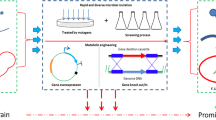Summary
Erwinia carotovora subsp. atroseptica produced flavour compounds when infecting endives (Cichorium intybus). These compounds were identified as esters and branched-chain alcohols.They were produced from amino acids and some of them such as methionol, methionol acetate, isobutanol, isobutyl acetate, β-phenyl ethanol and tryptophol were produced with good yields.
Similar content being viewed by others
References
Berger RG, Neuhauser K, Drawert F (1987) Biotechnological production of flavors using a strain of Ischnoderma benzoïnum. Biotechnol Bioeng 30:987–990
Gallois A, Gross B, Langlois D, Spinnler HE, Brunerie P (1990) Influence of culture conditions on the production of flavour compounds by 29 ligninolytic basidiomycetes. Mycol Res 94:494–504
Gross B, Gallois A, Spinnler HE, Langlois D (1989) Volatile compounds produced by the ligninolytic fungus Phlebia radiata Fr. (Basidiomycetes) and influence of strain specificity on the odorous profile. J Biotechnol 10:303–308
Hanssen HP, Urbash I (1990) 6-Pentyl-alpha-pyrone. A fungicidal metabolic product of Trichoderma spp. (Deuteromycotinae). In: Christiansen C, Munck L, Villadsen J (eds) Abstract book, 5th European Congress on Biotechnology, Copenhagen, 8–13 July, Munksgaard, Copenhagen, 1990, p 372
Langrand G, Triantaphylides C, Baratti J (1988) Lipase catalyzed formation of flavour esters. Biotechnol Lett 10:549–554
Lanza F, Kho Khee Hwee, Palmer JK (1976) Aroma production by cultures of Ceratocystis moniliformis. J Agric Food Chem 24:1247–1250
Latrasse A, Degorce-Dumas J, Leveau JY (1985) Production d'arômes par les microorganismes. Sci Aliment 5:1–26
Lee SM, Wroble MH, Ross JT (1989) l-Aspariginase from Erwinia carotovora: an improved recovery and purification process using affinity column. Appl Biochem Biotechnol 22:1–11
Raabo E, Terkildsen TC (1960) On the enzymatic determination of blood glucose. Scand J Clin Lab Invest 12:402
Vuillet S, Spinnler HE, Blachère H (1986) Analysis of amino-acid requirements of Clostridium thermocellum. Appl Microbiol Biotechnol 23:496–498
Waterer DR, Pritchard MK (1984) Monitoring of volatiles: a technique for detection of soft rot Erwinia carotovora in potato tubers. Can J Plant Pathol 6:165–171
Welsh FW, Murray WD, Williams RE (1989) Microbial and enzymatic production of flavor and fragrance chemicals. Crit Rev Biotechnol 9:105–169
Zaks A, Russell AJ (1988) Enzymes in organic solvents: properties and applications. J Biotechnol 8:259–270
Author information
Authors and Affiliations
Rights and permissions
About this article
Cite this article
Spinnler, H.E., Djian, A. Bioconversion of amino acids into flavouring alcohols and esters by Erwinia carotovora subsp. atroseptica . Appl Microbiol Biotechnol 35, 264–269 (1991). https://doi.org/10.1007/BF00184699
Received:
Accepted:
Issue Date:
DOI: https://doi.org/10.1007/BF00184699




